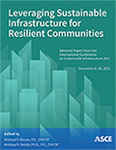Physical Modeling of Wave Height Attenuation through Flexible Vegetation
Publication: Leveraging Sustainable Infrastructure for Resilient Communities
ABSTRACT
About 40% of the world’s population lives within 100 km of the coast and is threatened by sea level rise and extreme weather events associated with increasing global temperatures and climate change. These hazards exacerbate the vulnerability of coastal communities to shoreline erosion and damage by waves and flooding. This project focused on the effectiveness of flexible vegetation as a noninvasive, sustainable, and resilient shoreline protection alternative. An idealized physical model was designed and constructed in a wave flume. Water surface elevations were measured seaward and leeward of the vegetation and a baseline case subjected to multiple wave conditions at two different water depths, to assess the effect of vegetation emergence or submergence on wave attenuation. Considering significant wave heights, transmission coefficients ranged from 0.32 to 0.39 and 0.73 to 0.90 for emergent and submerged conditions, respectively. Considering mean wave heights, transmission coefficients ranged from 0.60 to 0.70 and 0.82 to 0.91 for emergent and submerged conditions, respectively. Emergent vegetation resulted in smaller transmission coefficients (greater wave height attenuation) due to interruption of the entire wave profile.
Get full access to this article
View all available purchase options and get full access to this chapter.
REFERENCES
Anderson, M. E., Smith, J. M., and McKay, S. K. (2011). Wave Dissipation by Vegetation: Defense Technical Information Center. https://doi.org/10.21236/AD1003881.
Chaisson, C. (2012). Factors Influencing Stem Density of Creekbank Spartina alterniflora in a New England Salt Marsh. Botany Honors Papers. 3, 24 pp. http://digitalcommons.conncoll.edu/botanyhp/3.
Coops, H., Geilen, N., Verheij, H. J., Boeters, R., and van der Velde, G. (1996). Interactions between waves, bank erosion and emergent vegetation: an experimental study in a wave tank. Aquatic Botany 53:187–198. https://doi.org/10.1016/0304-3770(96)01027-3.
Gedan, K. B., Kirwan, M. L., Wolanski, E., Barbier, E. B., and Silliman, B. R. (2011). The present and future role of coastal wetland vegetation in protecting shorelines: Answering recent challenges to the paradigm. Climatic Change, 106(1), 7–29. https://doi.org/10.1007/s10584-010-0003-7.
Gittman, R. K., Popowich, A. M., Bruno, J. F., and Peterson, C. H. (2014). Marshes with and without sills protect estuarine shorelines from erosion better than bulkheads during a Category 1 hurricane. Ocean & Coastal Management, 102: 94–102, doi: https://doi.org/10.1016/j.ocecoaman.2014.09.016.
Gleason, M. L., Elmer, D. A., Pien, N. C., and Fisher, J. S. (1979). Effects of stem density upon sediment retention by salt marsh cord grass, Spartina alterniflora Loisel. Estuaries and Coasts 2(4): 271–273.
Houser, C., Trimble, S., and Morales, B. (2015). Influence of Blade Flexibility on the Drag Coefficient of Aquatic Vegetation. Estuaries and Coasts, 38(2), 569–577. https://doi.org/10.1007/s12237-014-9840-3.
Lei, J., and Nepf, H. (2019). Wave damping by flexible vegetation: Connecting individual blade dynamics to the meadow scale. Coastal Engineering, 147, 138–148. https://doi.org/10.1016/j.coastaleng.2019.01.008.
Lima, S. F., Neves, C. F., and Rosauro, N. M. L. (2006). Damping of gravity waves by fields of flexible vegetation. Proceedings of the 30th International Conference on Coastal Engineering. World Scientific. 491–503.
Manis, J. E., Garvis, S. K., Jachec, S. M., and Walters, L. J. (2015), Wave attenuation experiments over living shorelines over time: a wave tank study to assess recreational boating pressures. Journal of Coastal Conservation, 19: 1–11, doi:10.1007/s11852-014-0349-5.
Maza, M., Lara, J. L., Losada, I. J., Ondiviela, B., Trinogga, J., and Bouma, T. J. (2015). Large-scale 3-D experiments of wave and current interaction with real vegetation. Part 2: Experimental analysis. Coastal Engineering, 106, 73–86. https://doi.org/10.1016/j.coastaleng.2015.09.010.
Ozeren, Y., Wren, D. G., and Wu, W. (2014). Experimental Investigation of Wave Attenuation through Model and Live Vegetation. Journal of Waterway, Port, Coastal, and Ocean Engineering, 140(5), 04014019. https://doi.org/10.1061/(ASCE)WW.1943-5460.0000251.
Riffe, K. C., Henderson, S. M., and Mullarney, J. C. (2011). Wave dissipation by flexible vegetation. Geophysical Research Letters, 38(18), https://doi.org/10.1029/2011GL048773.
Smith, J. M., and Anderson, M. E. (2014). Limits of Wetland Dissipation. Coastal Engineering Proceedings, 1(34), 18. https://doi.org/10.9753/icce.v34.waves.18.
Wu, W., Zhang, M., Ozeren, Y., and Wren, D. (2013). Analysis of Vegetation Effect on Waves Using a Vertical 2D RANS Model. Journal of Coastal Research, 29 (2), 383–397.
Xia, J., and Nehal, L. (2013). Hydraulic Features of Flow through Emergent Bending Aquatic Vegetation in the Riparian Zone. Water, 5(4), 2080–2093. https://doi.org/10.3390/w5042080.
Information & Authors
Information
Published In
History
Published online: Jan 20, 2022
Authors
Metrics & Citations
Metrics
Citations
Download citation
If you have the appropriate software installed, you can download article citation data to the citation manager of your choice. Simply select your manager software from the list below and click Download.
